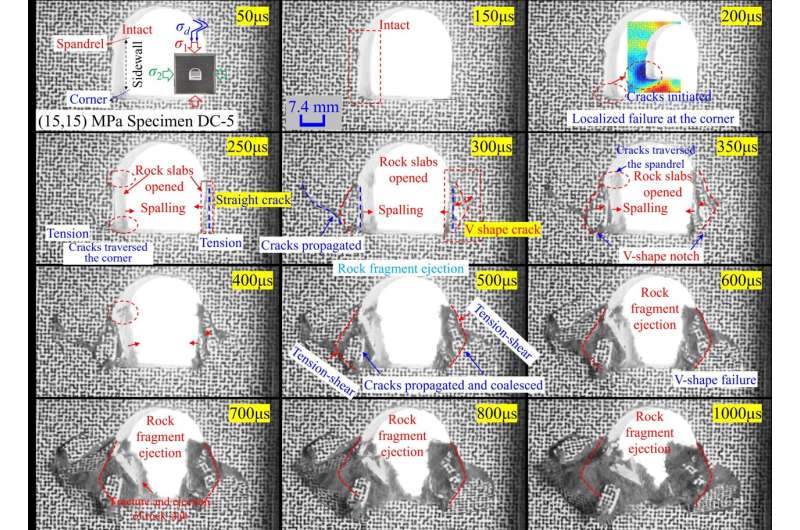by KeAi Communications Co., Ltd.

The biaxial Hopkinson pressure bar system. Credit: Wuxing Wu, Fengqiang Gong, Zong-Xian Zhang
Field observations have revealed that highly stressed D-shape tunnels experience sidewall rockburst triggered by impact loads stemming from rock blasting or other mining-related dynamic disturbances.
These phenomena can lead to sidewall failure and violent ejection of rock. The persistent occurrence of rockbursts poses a challenge to the safety construction of deep rock engineering projects. Consequently, there is an urgent need to investigate the sidewall rockburst of D-shape tunnel caused by impact load.
In a study recently published in the journal Rock Mechanics Bulletin, a team of scientists from Southeast University in China and University of Oulu in Finland conducted a systematic study on sidewall rockburst of D-shape tunnel under impact load. Their aim was to reveal the relevant rockburst processes, rockburst characteristics, and their triggering mechanisms.
“We developed an experimental capability to investigate the sidewall rockburst of the two-dimensional highly stressed D-shape tunnel under impact loading using the biaxial Hopkinson pressure bar system” explains Wuxing Wu, lead author of the study.
“Specifically, we focused on the sidewall rockburst process of D-shape specimen during the impact load loading process, examining the failure characteristics, strain field, and displacement deformation characteristics of the surrounding rock under different horizontal prestresses”

Real-time failure process of rockburst. Credit: Wuxing Wu, Fengqiang Gong, Zong-Xian Zhang
The team found that the sidewall failure process of D-shape specimen remained the same albeit under different two-dimensional static stresses, involving both tensile and tensile-shear failure.
However, the volume of the V-shape failure zone, affected range of tensile strain concentration zone, as well as severity of rockburst decreased with increasing horizontal prestress.
“These findings suggest that the sidewall rockburst of the highly stressed D-shape hole specimen under impact loading resulted from the interaction between static stress and impact load,” says Fengqiang Gong, corresponding author of the study.
“Static prestresses established the initial stress and strain distribution, while horizontal prestress influenced the affected range and strain values of the strain concentration zone.”
Notably, the impact load disrupted the original stress equilibrium, leading to alterations in the stress and strain of the surrounding rock, ultimately triggering rockbursts.
The team anticipates that their latest finding will garner more attention in the field of deep tunnel rockburst disasters. Above all, they hope that their findings offer valuable insights into the understanding and prevention of rockbursts.
More information:
Wuxing Wu et al, Sidewall rockburst of highly stressed D-shape hole tunnel triggered by impact load: An experimental investigation, Rock Mechanics Bulletin (2023). DOI: 10.1016/j.rockmb.2023.100094
Provided by
KeAi Communications Co., Ltd.
Citation:
Study reveals rockburst processes, characteristics and triggering mechanisms (2024, May 6)
retrieved 6 May 2024
from https://phys.org/news/2024-05-reveals-rockburst-characteristics-triggering-mechanisms.html
This document is subject to copyright. Apart from any fair dealing for the purpose of private study or research, no
part may be reproduced without the written permission. The content is provided for information purposes only.
>>> Read full article>>>
Copyright for syndicated content belongs to the linked Source : Phys.org – https://phys.org/news/2024-05-reveals-rockburst-characteristics-triggering-mechanisms.html































